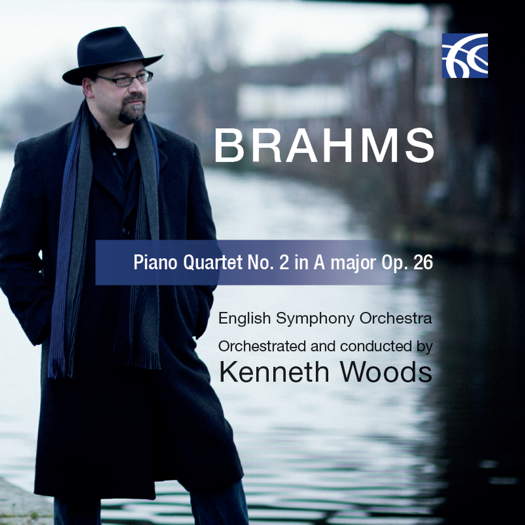 SPONSORED: CD Spotlight. A Very Joyous Disc - Brahms arranged by Kenneth Woods impresses Alice McVeigh.
SPONSORED: CD Spotlight. A Very Joyous Disc - Brahms arranged by Kenneth Woods impresses Alice McVeigh.
All sponsored features >>
- Wagner: Tristan und Isolde
- Giordano
- Teatro alla Scala
- Renaissance music
- oratorio
- Stanislaw Skrowaczewski
- Bratislava
- Minneapolis Symphony Orchestra
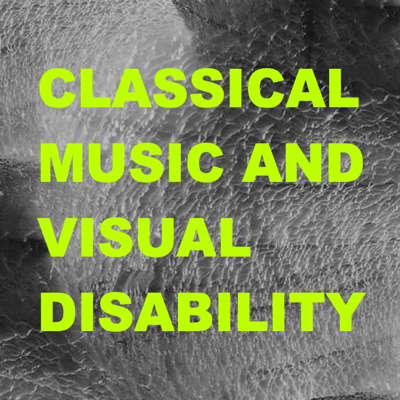 PODCAST: John Dante Prevedini leads a discussion about Classical Music and Visual Disability, including contributions from Charlotte Hardwick, Robert McCarney, Halida Dinova and Giuseppe Pennisi.
PODCAST: John Dante Prevedini leads a discussion about Classical Music and Visual Disability, including contributions from Charlotte Hardwick, Robert McCarney, Halida Dinova and Giuseppe Pennisi.
Mahler's 'Resurrection'
GIUSEPPE PENNISI reports on an
Accademia Nazionale di Santa Cecilia
performance in Rome
Italy took quite some time to appreciate the music of Gustav Mahler, but now, by large symphony orchestras, the Bohemian is one of the most often performed composers.
In Rome in 2010 and 2011, for the 150th anniversary of Mahler's birth and the centenary of his death, two orchestras competed to perform all his symphonies - a mammoth undertakings, as I reported in 'Mahler versus Mahler', published in Music & Vision Magazine on 15 May 2010. Antonio Pappano, music director of the older, larger and better endowed group - the symphony orchestra of the National Santa Cecilia Accademy, began the series, on 10 May 2010, not with the first symphony but with the huge second symphony, composed in memory of Hans von Bulow. The second symphony is the clearest example of Mahler's revolution in symphonic composition. In this symphony, for the first time, Mahler introduced the human voice, more specifically, the Lied, into the symphonic texture. Mahler's second symphony had a long and painful birth, even though it sounds so compact, in spite of its ninenty minute length. The symphony is also a clear example of 'program music'. Mahler contended that he did not like to be classified as a 'program music' composer. However, he himself wrote the 'program' for this symphony. In addition, his 'symphonic poems' are the best examples of late nineteenth century 'program music'.
It is hard to imagine that a work as unified and as powerfully structured as Mahler's second symphony could have required such a long and painful composition, more than six years between the initial sketches and the completion of the vast final movement. Mahler was still only twenty-eight when he completed his first symphony in 1888 at the height of the opera season in Leipzig, where he had held the position of chief conductor for the previous two years. The ink was barely dry on the score when he began to toy with the idea of a second symphony, this time in C minor. The opening movement was soon completed but for the next five years existed independently under the heading of Todtenfeier (Funeral Ceremony), a title borrowed from the German translation by his boyhood friend Siegfried Lipiner of an epic poem by leading Polish writer Adam Mickiewicz. Completed in Prague in August 1888, the full score of the Todtenfeier languished among Mahler's papers because, after his appointment as director of the Budapest Opera at the end of the year, he was far too busy with his artistic and administrative responsibilities to return to composition.
Death is central to Mahler's music. Mahler was a non-practicing Jew and his much advertised conversion to the Roman Catholic Church in one of the most important Churches in Vienna in 1897 was most likely only a means (and a requirement) to be appointed as general director of Vienna Opera. His latest compositions, however, indicate that he believed in the afterworld, most probably in a Zen concept and vision.
His second symphony, titled Resurrection, deals with the Christian vision of death and resurrection. In the symphony's first movement, the protagonist is buried after a long struggle with 'life and destiny'. He casts a backward glance at his life, first at a moment of happiness (depicted in the second movement) and then (in the Scherzo) at the cruel hurly-burly of existence, the 'bustle of appearances' and the 'spirit' of disbelief and negation' that had seized hold of him. In Mahler's own words, he despairs of himself and of God. In the fourth movement, 'the stirring words of simple Faith sound' in the hero's ears, and hold out the promise of light. As for the final movement: 'The horror of the day of days has come upon us. The cry for mercy and forgiveness sounds fearful in our ears. The wailing becomes gradually more terrible. Consciousness dies as the Eternal Judge approaches. The Last Trump sounds; the trumpets of the Apocalypse ring out. In the eerie silence that follows, we can just barely hear a last tremulous echo of earthly life. The gentle sound of a chorus of saints and heavenly hosts is then heard: 'Rise again, yes, rise again thou wilt!' Then God, in all His glory, comes into sight. A light strikes us to the heart. All is quiet and blissful. A feeling of overwhelming love fills us with blissful knowledge and illuminates our existence.
Mahler's second symphony is often performed in the National Santa Cecilia Academy's program. Conductors have different interpretations of the score. For instance, in 2010, Pappano read the symphony as a melodrama. In the first movement, we felt echos of Beethoven's Eroica and Wagner's Götterdämmerung, as well as Verdi, especially in the solemn 'Dies Irae'-related chorale, introduced by the horns. In 2014, Myung-Whung Chung, a devout Roman Catholic, gave a quite different, very religious reading. There are, of course, differences also in the recordings by major conductors. Before the 30 May 2019 concert reviewed here, I listened to a late-Romantic reading by Rafael Kubelik, a philosophical interpretation by Zubin Mehta and a gentle and embroidered version by Simon Rattle.
On 30 May 2019, Mikko Franck, principal conductor of the National Academy symphony orchestra, emphasized the mysticism of the composition. I was in the audience.
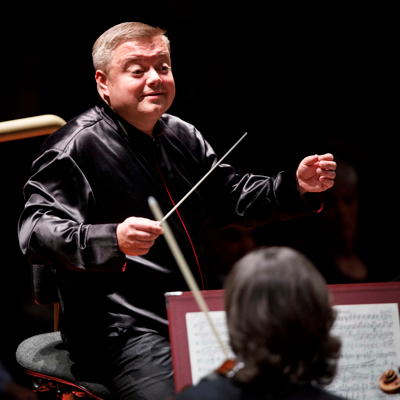
Mikko Franck conducting Mahler's Resurrection Symphony in Rome. Photo © 2019 Musacchio, Ianniello & Pasqualini
In the first movement, the protagonist's death is seen as a passage from human adventure to eternity with the 'Scherzo' seen as a memory of moments of joy in the life he is about to leave forever.
Within this overall concept, in the third and the fourth movements, and especially in the 'rose song' O Röschen rot, beautifully rendered by Gerthild Romberger, the approach is very serene - the Peace of the after-life.
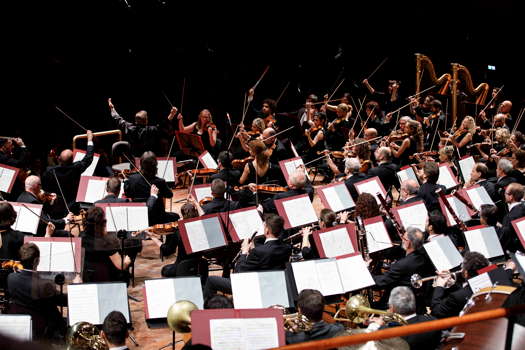
Mikko Franck and L'Orchestra dell'Accademia Nazionale di Santa Cecilia. Photo © 2019 Musacchio, Ianniello & Pasqualini
In the long and exciting fifth and final movement, with the 'Resurrection' anthem sung in an enthralling manner by alto Gerthild Romberger, soprano Genia Kühmeier and a monumental chorus led by Ciro Visco, Franck gave a strong sense of prayer to the glory of God. The orchestra was superb and Franck enveloped the audience with sound by placing the brass on the tier above the orchestra and chorus.
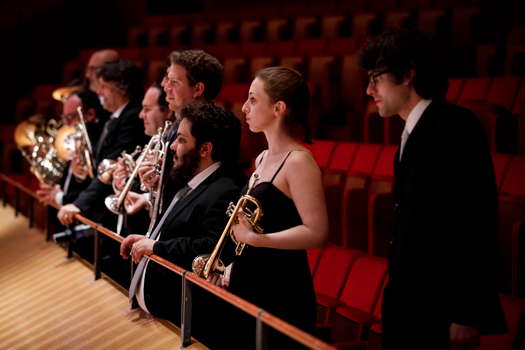
Brass players from L'Orchestra dell'Accademia Nazionale di Santa Cecilia. Photo © 2019 Musacchio, Ianniello & Pasqualini
Franck, the orchestra and the chorus were rewarded with twelve minutes of applause and accolades.
Copyright © 1 June 2019
Giuseppe Pennisi,
Rome, Italy



